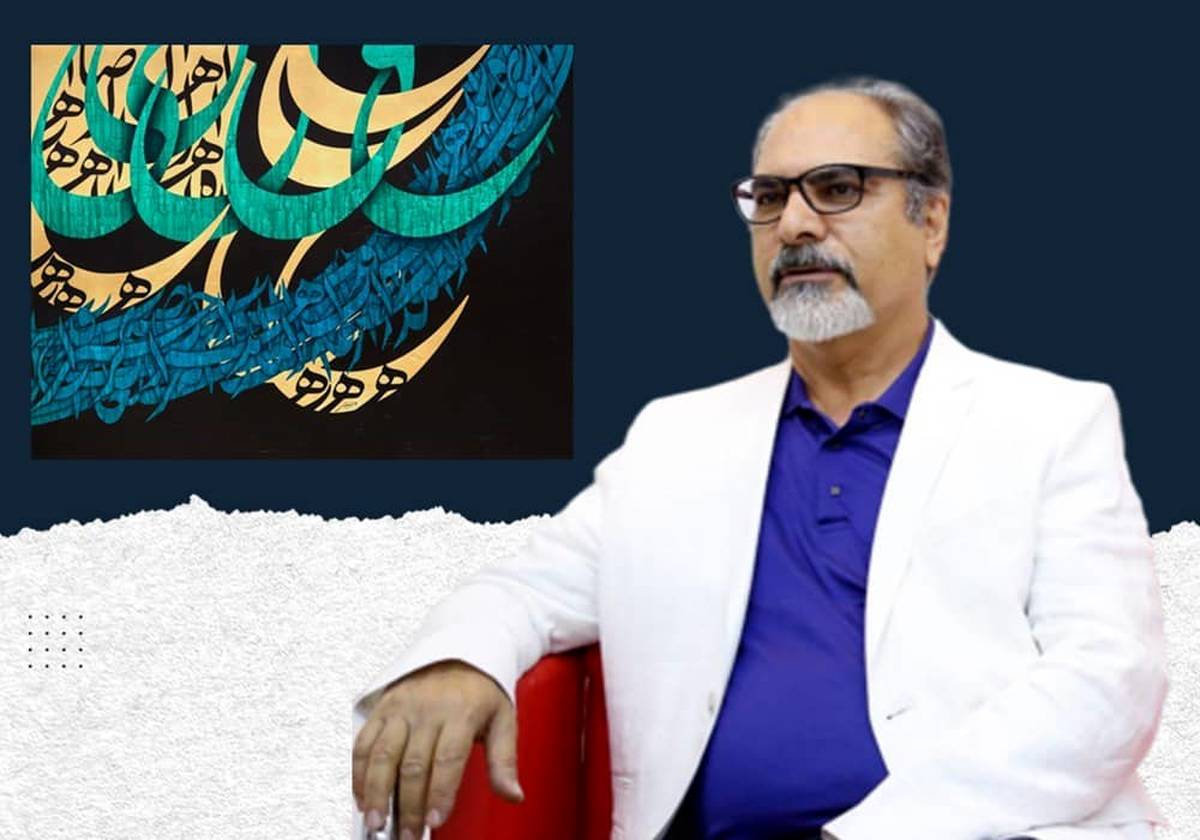
Ali Shirazi | Gholam Hossein Amirkhani | Ali Shirazi Calligraphy
Ali Shirazi and Formalism / Gholam Hossein Amirkhani: A Novel Perspective on Calligraphy through the Work of Ali Shirazi
Gholam Hossein Amirkhani: A Novel Perspective on Calligraphy through the Work of Ali Shirazi.
ArtDayME : Here is an example of maestro Ali Shirazi's calligraphy, which uses four colors and a form-based style. Because of its unique composition, the audience is presented with several analyses based on their personal experiences. However, understanding the viewpoint of Gholam Hossein Amirkhani, the renowned expert of Iranian calligraphy, can aid in accurately interpreting Shirazi's compositions.
1:
This 180 by 150 cm piece was created in 2012 using acrylic and gold leaf on canvas. The great calligrapher has taken advantage of the three-cornered combination of Nastaliq effects on a black backdrop, which is typically his preferred medium: from Siyah mashq (also known as "black practice") to large, single, and circular letters, and of course the letter "h" (in Persian "هـ"), which is one of the artist's favorites and is written both elegantly and satirically.

2:
It appears as though a bright and cheery downpour of green, golden yellow and blue characters has descended onto the gloomy night. A significant shift is indicated by the golden corner on the upper left and the black corner on the lower right. The tranquility of the upcoming season is promised by the thundering surge of blue Siyah mashq in the interim.
The main characters in the scenario are formed letters' edges and potentially additional circular letters; they can also offer information about the changing of the times. Using little and large pen strokes, the artist produced textures on the body and trunk of the letters that aid in revealing the depth of the piece.
3:
And one letter (s) ("ص") is like an eye that never looks away from the spectator, and there are over ten letters "h" ("هـ") in varying sizes scattered throughout the artwork.
4:
On February 19, 2012, Gholam Hossein Amirkhani, the renowned calligraphy expert in Iran and the Middle East, made some remarks in his description of Ali Shirazi's calligraphy pieces that will undoubtedly aid in the interpretation of this piece as well as his others.
Excerpts from Amirkhani's words:
"In my opinion, artists should approach calligraphy with awareness and by following the steps of artistic expertise. While having good taste is important, having a scientific foundation is crucial. To be able to grow in an art, you have to be anchored in it. One blatant illustration of this perspective is Master Ali Shirazi. His twenty-one exquisite calligraphy paintings in the Nastaliq exhibition at the Shirin Gallery serve as evidence for this assertion. Iranian calligraphy has a long and enduring legacy thanks to Master Shirazi. He advanced through the degrees of expertise and advancement over a 40-year period, using care and perseverance in traditional Nastaliq calligraphy, until he became known as one of the most influential, formidable, and resourceful Nastaliq artists in history. He attained the pinnacle of popularity and recognition for adhering to the norms and nuances with his Nastaliq charisma. With this background, he subsequently ventured into the new field of calligraphy. Fortunately, Master Shirazi has preserved Nastaliq's calligraphy lineage, and his works are clearly original. Unlike any other master who has worked in this field, he stays away from imitation and repetition and is extremely committed to calligraphy. Shirazi owns his personal workspace, which is distinctive. He has been able to offer a fresh perspective on this emerging style and develop a new approach that incorporates both contemporary visual elements and traditional guidelines."

5:
Many works of master Ali Shirazi are kept in the prestigious collections of the Middle East, such as: Mohammad Al Murr in the United Arab Emirates; the Al Owais Institute in Dubai; the Anwar Gargash collection in Dubai; the Juma Al Majid collection in Dubai; the museums in Sharjah, Doha, and Qatar; the most significant private collectors, such as Pasargad Bank of Iran; and religious collections in Iran, including Tehran's Quran Museum and Imam Ali Religious Arts Museum.
Similar to his traditional artworks, Shirazi's contemporary calligraphies are achieving extraordinary popularity in the Middle Eastern art market. In addition to his 2012 Christie's auction record of $60,000 and his most recent sale of a piece at the 19th Tehran Auction for $33,400, he has had other noteworthy and profitable auction sales at Bonhams London and other auction houses; examples of these may be found on reliable websites like Art Price.
https://images.app.goo.gl/KfPodCaRJG7eBnGg9

LEAVE A RELPY